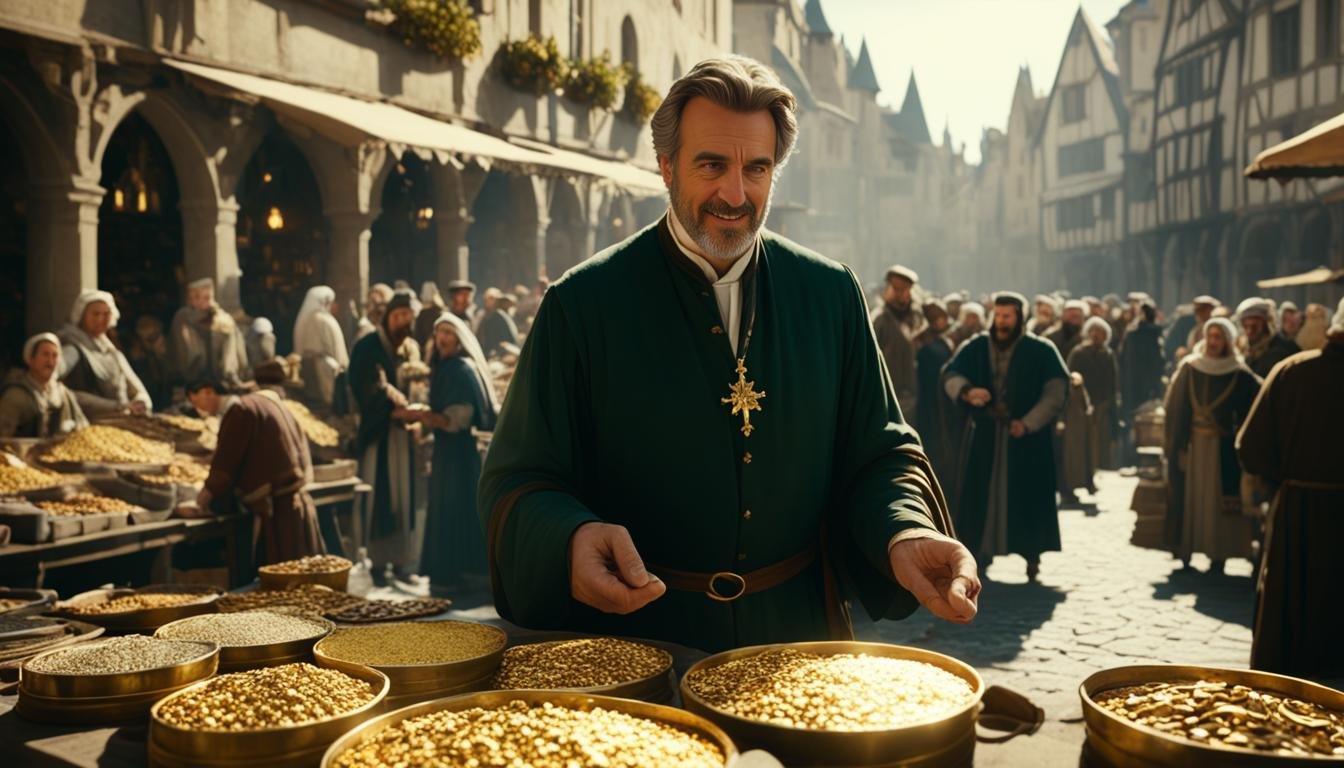Did you know, back in the Middle Ages, two-thirds of the gold around the Mediterranean came from West Africa?
This shows how big the influence of West African gold empires was on global trade. It changed economies and wealth everywhere. But how did gold from Africa get so important in medieval society?
Gold was very valuable and linked Africa, Europe, and the Islamic world together through trade. For more than 500 years, West Africa was a big producer of gold. Its gold was key in creating famous empires such as Ghana and Mali. Caravans traveled through the dangerous Sahara Desert, making sure gold reached the Mediterranean. There, it was used to make coins and luxury goods.
The Portuguese and later Europeans were also attracted to the Americas because of gold. This shaped the economic world of the Middle Ages. Gold mining, trade routes, and the luxury of African empires all played a big role. From kings to religious groups, everyone wanted the pure gold from West Africa. It affected trade both close to home and across seas.
Key Takeaways about Gold in the Middle Ages
- West Africa produced two-thirds of the gold circulating in the medieval Mediterranean at the peak of the gold trade.
- The Ghana Empire, renowned as the ‘land of gold,’ significantly influenced the global trade network.
- Mansa Musa’s legendary pilgrimage to Mecca epitomized the wealth and influence of the Mali Empire.
- Camel caravans facilitated the consistent flow of gold from West Africa to North Africa, promoting trans-Saharan trade.
- The intricate trade routes and economic dynamics of the Middle Ages were heavily dependent on the supply and demand for gold.
Introduction to Gold’s Role in Medieval Society
Gold was very important in medieval times. It was at the core of wealth and trade. Gold also stood for power and high status. It was used as money and as something to show off.
The Value of Gold
Gold was valued for its rarity and beauty. It was key for business and seen as a sign of wealth. It was used in trading, even for bartering with gold items of equal value. Making coins from gold made trading easier and more widespread.
Gold as a Status Symbol
Gold showed people’s wealth and social position. Leaders and rich people liked to have and show off gold items. In the Ghana Empire, certain gold pieces showed the king’s might. Also, the Mali Empire’s leader, Mansa Musa I, impressed with his gold. On a trip to Mecca, he carried so much gold that it affected markets for years.
Sources of Medieval Gold
West Africa, particularly places like Bambuk, Bure, and around the Niger River, was a big source of gold. This region provided much gold for the Mediterranean area in medieval times. The Ghana Empire earned the nickname ‘land of gold’ for its key role in trading this precious metal. A big block of salt from Timbuktu could be traded for a lot of gold. This shows the strong trade connections.
The Mali Empire was also a big player in the gold trade. Mansa Musa I had such a grand amount of gold on his Mecca journey that it affected markets. Gold was crucial for the economy in those times.
Gold Production and Mining Techniques
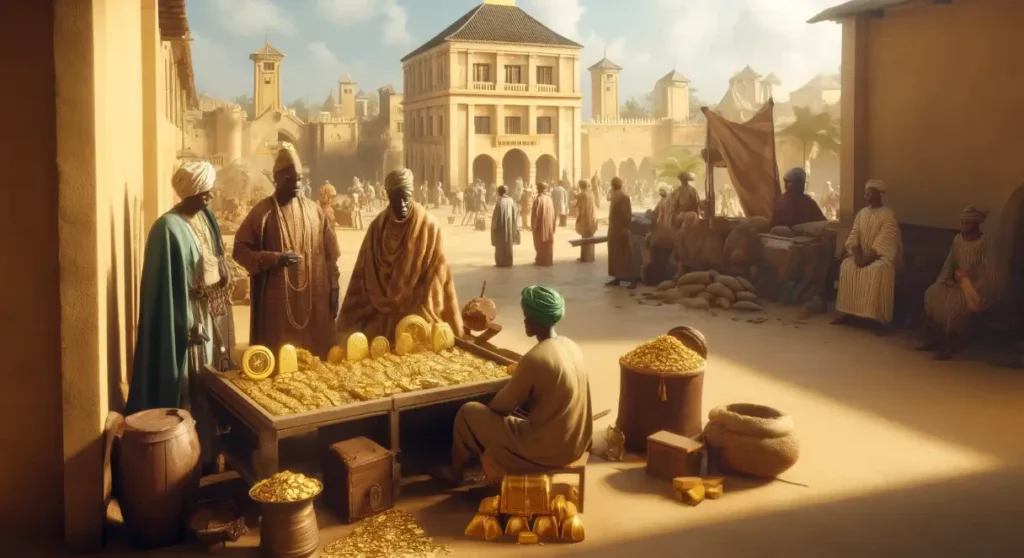
Gold was hugely important during medieval times, especially in West Africa. This region was well-known for having a lot of goldfields. People used many different ways to get gold out of the ground and make it pure.
Alluvial Gold Mining
One key method was gold panning. Miners would look for gold in riverbeds using this technique. It let them collect tiny pieces of gold easily. West Africa was great at this, which helped it become a big gold supplier. They used thousands of mining shafts to collect gold. In places like the Ghana Empire, the gold was traded for things like salt, ivory, and slaves.
Gold Refinement Processes
After mining, gold was made pure through refining. They often melted the gold to form easy-to-carry bars. This step made sure the gold was pure. Gold from places in Africa like Ghana and Burkina Faso was very important. The Mali Empire used this gold to show off their wealth. This was clear when their leader, Mansa Musa I, went on a famous pilgrimage to Mecca.
Gold Mining in Africa
Gold mining was huge in Africa during medieval times. The Ghana Empire was a center for this activity. They had many mine shafts and produced lots of gold, mostly in small pieces. This gold was not often made into coins but was key in trade. West Africa had rich goldfields with gold found in shallow mines and riverbeds. People used different ways to mine gold but always aimed to get as much as possible.
“Gold production in medieval West Africa not only sustained local economies but also fed into the global gold trade, significantly impacting the medieval Mediterranean market.”
Many empires, like the Mali Empire, expanded to control more goldfields. This boosted their economies. The African goldfields attracted a lot of attention from around the medieval world. This showed Africa’s central role in the history of gold trade.
The Ghana Empire – Land of Gold
The Ghana Empire shined as the land of gold during medieval Africa, from the 7th to 13th century. Its wealth came from lots of gold and control over big trade routes across the Sahara. This made it a key player in the medieval African business world. Its main city, possibly Kumbi (Koumbi Saleh), was about 200 miles north of today’s Bamako, Mali.
Goldfields and Mining Practices
Places like Ghiyaru and Galam in the Ghana Empire were known for their gold riches. People dug for gold dust in shallow mines. But if they found big nuggets, that gold belonged to the king. This helped the economy and showed the king’s powerful position.
Trade Routes and Commerce
The Ghana Empire was perfect for the Sahara’s trade. It was a key link for moving gold to North Africa and the Mediterranean. About two-thirds of the West African gold in the medieval Mediterranean came from this empire. In the trade, gold was swapped mainly for salt, which was very valuable. For instance, gold worth about 450 grams could buy the amount of salt that would normally sell for half that gold’s weight.
Royal Control Over Gold
The Ghanaian kings made sure to control the big gold finds. They kept any large nuggets, showing their power and keeping the market steady. Some Arab writers mentioned a Ghana king having a massive gold block weighing over 13.5 kilos. This shows how much gold and wealth the kings managed.
Gold power helped the Ghana Empire thrive until outside pressures caused its end. Challenges like the Muslim Almoravids and the Susu taking its capital led to its fall. By 1240, the Mali Empire had absorbed what was left of the Ghana Empire. This marked the end of its independent rule.
The Role of Gold in the Islamic North African Empires
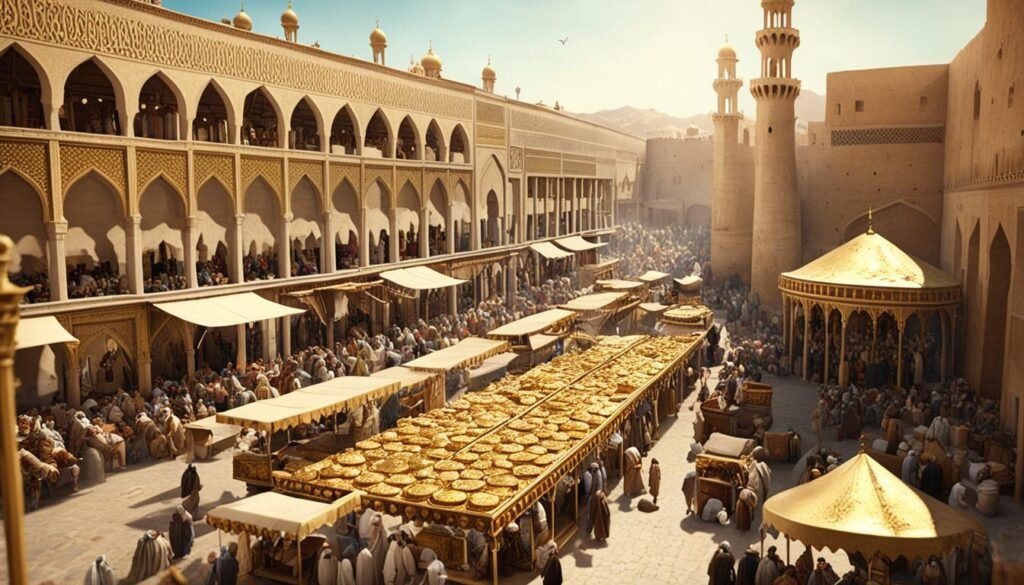
In the Middle Ages, West Africa stood out as a top gold producer. Around two-thirds of the gold in the medieval Mediterranean came from here. This source led to a big demand for gold in the North African Islamic empires. They used gold for many things, even though they had rules against men wearing it.
Gold jewelry was a significant part of medieval fashion due to its detailed designs and value. For example, the Roman city of Tripolitania became wealthy by trading olive oil, pottery, and, most importantly, for West African gold. This gold didn’t just decorate people; it was also used to make Islamic manuscripts beautiful and important.
The arrival of gold from West African mines boosted trade in North Africa. This made cities like Marrakesh and Tunis vital trade centers. Gold played a crucial part in making coins to support armies and in buying and selling. The connection between gold jewelry, beautiful manuscripts, and trade networks helped Islamic empires thrive.
The Mali Empire got its gold from new fields in what is now Burkina Faso and Ghana. This new wealth surpassed the previous Ghana Empire. Mansa Musa’s trip, carrying 135 kilos of gold dust, showed the empire’s wealth. It changed prices in places like Cairo and affected the region’s economy greatly.
Trade between north and south of the Sahara grew between the 7th and 11th centuries. This linked the hungry-for-gold north with the gold-rich south. Gold was as valuable as goods like a 90-kilo salt block from Timbuktu, showing the detailed trading system’s balance and value.
In the 8th and 9th centuries, Arab traders started buying gold from Berbers in Moroccan towns. This encouraged more Berbers to convert to Islam, showing how gold trading impacted the people and the religion. The mix of gold from Ancient Ghana with Islamic trade drew hundreds of thousands of Africans into the golden trade. It was large and had a huge influence.
Impact of Gold on Medieval European Economies
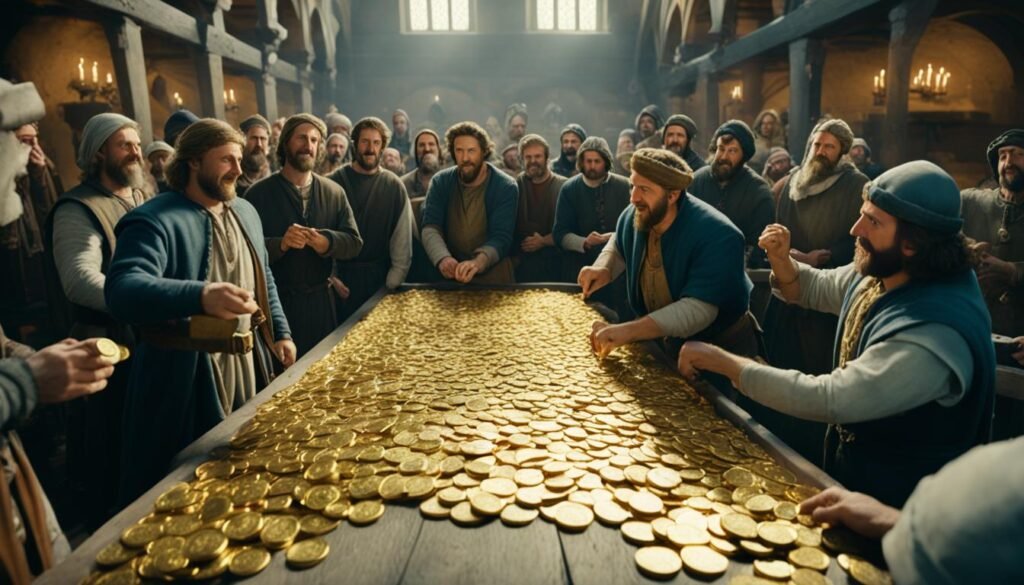
Gold made a big difference in medieval Europe, especially with the start of gold coins. This new way of using money changed how people traded and showed their wealth. Gold was very attractive in those times, changing how society was structured and how business was done.
The Introduction of Gold Coins
The use of gold coins changed economic systems, making them more active. In 1257, the English began using a gold penny to give to the poor. This made trading easier and more efficient. Gold coins like the leopard were used by 1344, making trade simpler and helping people save money.
Gold in Medieval England
In England, people used various gold coins, such as the noble and the rose noble. These coins showed the kingdom’s wealth and power. Gold was key to economic plans in the Middle Ages. It helped pay for large projects and the government’s needs, showing how important gold was to the economy.
Medieval Financial Records of Gold
Recording gold transactions in detail shows how important gold coins were. People kept track of gold in shillings, pounds, and marks. This detailed record-keeping shows how gold was a key part of how society showed wealth and power. It proves gold coins were central to the Middle Ages’ economy.
| Coin Type | Value (in pence) | Introduction Year |
|---|---|---|
| Leopard | 36 | 1344 |
| Groat | 4 | 1351 |
| Noble | 80 | 1351 |
| Rose Noble | 120 | 1464 |
Gold coins not only made trading easier but also changed the whole financial system in medieval Europe. This change, brought by the use of gold coins, played a key part in the economy and politics of the Middle Ages.
Mansa Musa and the Mali Empire’s Wealth
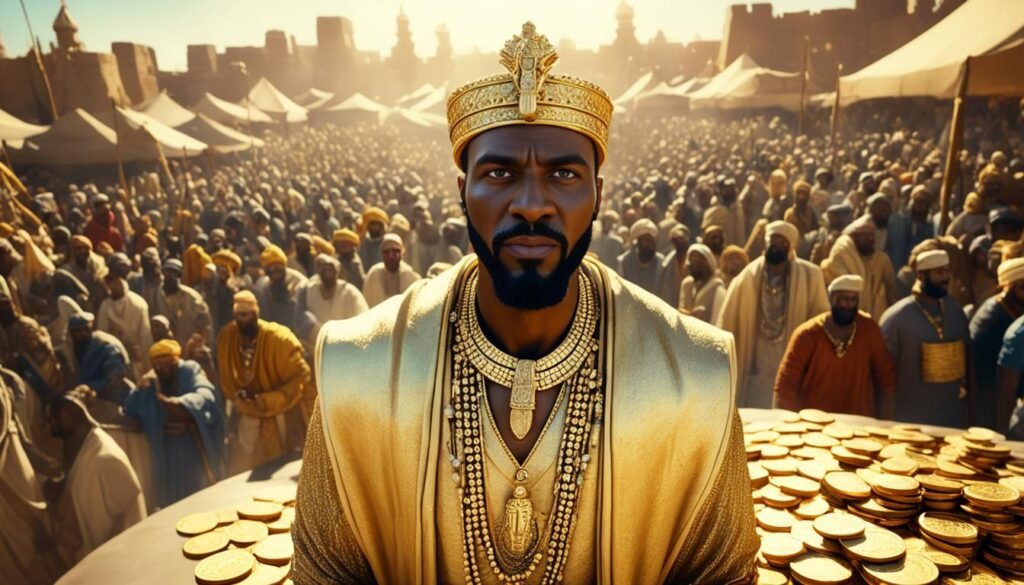
Mansa Musa ruled from 1312 to 1337 C.E. as king of the Mali Empire. His kingdom stretched through much of West Africa, including areas like modern-day Mali and Senegal. Mali was rich in gold and controlled important trade routes across the Sahara. This made Musa and his empire very wealthy.
Mansa Musa’s Pilgrimage to Mecca
In 1324 C.E., Mansa Musa went on a pilgrimage to Mecca, showing off Mali’s considerable riches. He traveled with a huge group, including 60,000 men, 12,000 of whom were slaves. They were joined by 80 camels loaded with 136 kilograms (300 pounds) of gold each.
During his journey, Musa shared his wealth by giving gold to the poor and building mosques. This caused the price of gold to drop in Egypt for over a decade after his visit.
Mali’s Gold Trade
Mali was known for its gold, and this brought great wealth. Musa controlled areas like Bambuk and Wangara, known for their gold. By dominating the gold trade, Mali grew richer. An old map, the Catalan Atlas, shows Mansa Musa sitting on a throne with a golden nugget and a staff. This symbolizes his power over gold in Africa.
Under Musa’s rule, Timbuktu became a major place for learning. The empire’s success in the gold trade helped develop Timbuktu into an important center for Islamic studies.
| Aspect | Detail |
|---|---|
| Reign Duration | 25 years (1312 C.E. – 1337 C.E.) |
| Mecca Pilgrimage | 1324 C.E., Tens of thousands in the entourage, 136 kg of gold per camel |
| Impact on Gold Value | Decrease in Egypt for 12 years due to Musa’s spending and gifts |
| Depiction in Catalan Atlas | Mansa Musa holding a golden nugget and staff |
| Major Development in Mali | Timbuktu becoming a significant Islamic university center |
Gold in the Middle Ages: Medieval Wealth & Trade
In the Middle Ages, gold played a big role in wealth and trade. It traveled from West Africa to Europe. There, it powered strong and complex economies. The Ghana Empire, known as the ‘land of gold,’ showed how using gold could boost trade for hundreds of years.
West Africa was very important in making gold back then. It sent two-thirds of all medieval gold to the Mediterranean. Camel caravans helped move gold and other items, making trade quicker. Cities like Timbuktu and Djenne traded things like salt for gold.
In places like the Ghana Empire, kings owned a lot of gold. Even a small gold piece, like a nugget, was royal property. There was a king who had a huge 13.5-kilo gold block, showing off the riches of these empires.
Mansa Musa I of the Mali Empire was a great example of someone rich in gold. In 1324, he went to Mecca with a grand group. They carried plenty of gold dust and slaves with gold staffs. His journey made places like Cairo flourish, showing how gold could drive economies.
Gold from West Africa was known for its purity. It was perfect for making money and fancy items. Books like “Caravans of Gold, Fragments in Time” talk about this. They cover everything from artifacts to coins, showing the age’s wealth and power.
| Region | Gold Production | Economic Impact |
|---|---|---|
| West Africa | Two-thirds of medieval Mediterranean gold | Boosted trans-Saharan trade and economic growth |
| Ghana Empire | Controlled significant gold nuggets | Stabilized gold markets and reinforced royal power |
| Mali Empire | Immense gold wealth through tribute and trade | Mansa Musa’s pilgrimage influenced regional economics |
The trade routes in the Middle Ages changed history. They used new ways to move things, like caravans. These routes connected many places, creating a big web of social, political, and economic ties. These ties show how gold influenced the Middle Ages all over the world.
European Explorers and the Quest for Gold
During the Age of Discovery, the longing for gold drove many European expeditions. These adventures changed global history and shaped economies worldwide. Armed with tales of riches, explorers braved dangerous trips to chase after wealth and fame.
Inspiration from Marco Polo’s Travels
Marco Polo’s travels in the 13th century, detailed in “The Travels of Marco Polo,” captivated European minds. His descriptions of Asia’s wealth, especially gold, sparked a keen interest. This influenced a new wave of European exploration to find trade routes to the East’s treasures.
Christopher Columbus and the Exploration of the New World
In 1492, Christopher Columbus set sail driven by the desire to find gold. He was keen to learn if the Americas held this precious metal. While he found very little in gold mines, his voyages inspired others to explore these lands further.
Spain’s Search for El Dorado
Spain’s hunt for El Dorado symbolized the European obsession with gold. This mythical city, said to be overflowing with gold, led to many expeditions. Conquistadors brought back great treasures, highlighting the New World’s wealth.
One famous story is of Pizarro finding Atawallpa, who offered vast riches for his release. The treasure was so huge it filled a room with gold and two with silver. This event showcased the vast wealth in the Americas.
The influx of New World gold greatly boosted Europe’s economy. It strengthened Spain’s power and encouraged more European exploration. This eventually led to widespread colonization and dramatic changes in the world’s political map.
- Marco Polo’s stories motivated European dreams of wealth and expeditions.
- Christopher Columbus’s gold-focused voyages changed how the world explored.
- Spain’s relentless pursuit of El Dorado with Cortés and Pizarro revealed the endless quest for gold.
The search for New World gold left a lasting impact on global economic and political history. As Europe expanded its power, gold continued to play a vital role. Its pursuit significantly shaped the world we see today.
Conclusion
The medieval period changed society greatly. Gold was key in this change, affecting not just money but culture and politics too. It started with the first gold penny in 1257, leading to coins like the noble and angel. These coins showed wealth and stability. The way these coins were crafted, with detailed hand-trimming, meant keeping the coin economy strong was a top priority.
The use of gold in coins changed the game. By 1205, only £250,000 in gold was traded. However, by 1313, this number jumped to £2,000,000. This growth was vital for business and daily spending. In the 14th century, each person had at least eighty coins. This was a big jump from 1066, when people might only have one or two silver pennies. Taxes and the collection of coins by the Crown boosted this rapid exchange of money.
Gold continues to hold a special place in history. For instance, in 1966, an important gold find called the “Fishpool Hoard” was unearthed. It contained 1,237 gold coins from about 1464. This, plus the use of silver pennies by Offa and the creation of new coins, showed just how much society relied on coins. Even when coins were scarce, people turned to using goods to settle debts. Gold’s lasting impact is clear, shaping the world economically, socially, and politically.
FAQ about Gold in the Middle Ages
How was gold significant in medieval trade and wealth?
During the Middle Ages, gold played a key role in the economy. It fueled huge empires to life and led to increased trading. Across places like the Sahara and Europe, gold was seen as a mark of wealth and status. This made it vital for the wealth of many people.
What role did West Africa play in the medieval gold trade?
West Africa stood out as a top producer of gold. Areas like Bambuk, Bure, and the upper Niger River had plenty of gold to offer. The Ghana and Mali Empires distributed this gold, trading through the Sahara to Europe and North Africa.
What mining techniques were used to extract gold in medieval times?
Back then, miners often used basic methods like panning in riverbeds. For areas rich in gold, mining shafts were dug deep. These techniques allowed for efficient gold gathering before it was turned into bars for trading.
How did the Ghana Empire control and utilize its gold resources?
The Ghana Empire carefully managed its gold, which kept its value high. By controlling the gold trade, they strengthened their economy and political influence. This made them a powerful player in the trade networks crossing the Sahara.
What was the significance of gold in the Islamic North African empires?
In Islamic North Africa, gold was not just a symbol of wealth. It was vital for making jewelry, coins, and trading with Europe. Key cities like Marrakesh and Tunis became wealthy trading posts, thanks to their roles in moving gold from West Africa throughout the Mediterranean.
How did the introduction of gold coins impact medieval European economies?
The use of gold coins marked a big change in medieval Europe. They made trading easier and showcased a country’s wealth. Coins like the English noble and Florentine florin set a standard. These ancient coins show how crucial gold was in shaping the Middle Ages economy.
What was Mansa Musa’s contribution to the Mali Empire’s wealth and gold trade?
Under Mansa Musa, the Mali Empire became famous for its gold. His pilgrimage to Mecca was a display of the empire’s vast wealth. This boosted trade and influenced places like Cairo. His empire’s success was tied closely to its riches in gold.
How did European explorers seek gold in the medieval period?
Thanks to stories from explorers like Marco Polo, Europeans went on quests for gold. Christopher Columbus’s travels to the Americas are well-known. The search for mythical places like El Dorado was part of the European desire for wealth, changing the world’s power and riches with each new gold find.
Source Links
- https://www.blockmuseum.northwestern.edu/publications/caravans-of-gold,-fragments-in-time.html
- https://www.worldhistory.org/article/1383/the-gold-trade-of-ancient–medieval-west-africa
- https://magazine.northwestern.edu/features/caravans-of-gold-fragments-in-time/
- https://www.worldhistory.org/article/1383/the-gold-trade-of-ancient–medieval-west-africa/
- https://en.wikipedia.org/wiki/Gold_mining
- https://www.britannica.com/place/Ghana-historical-West-African-empire

